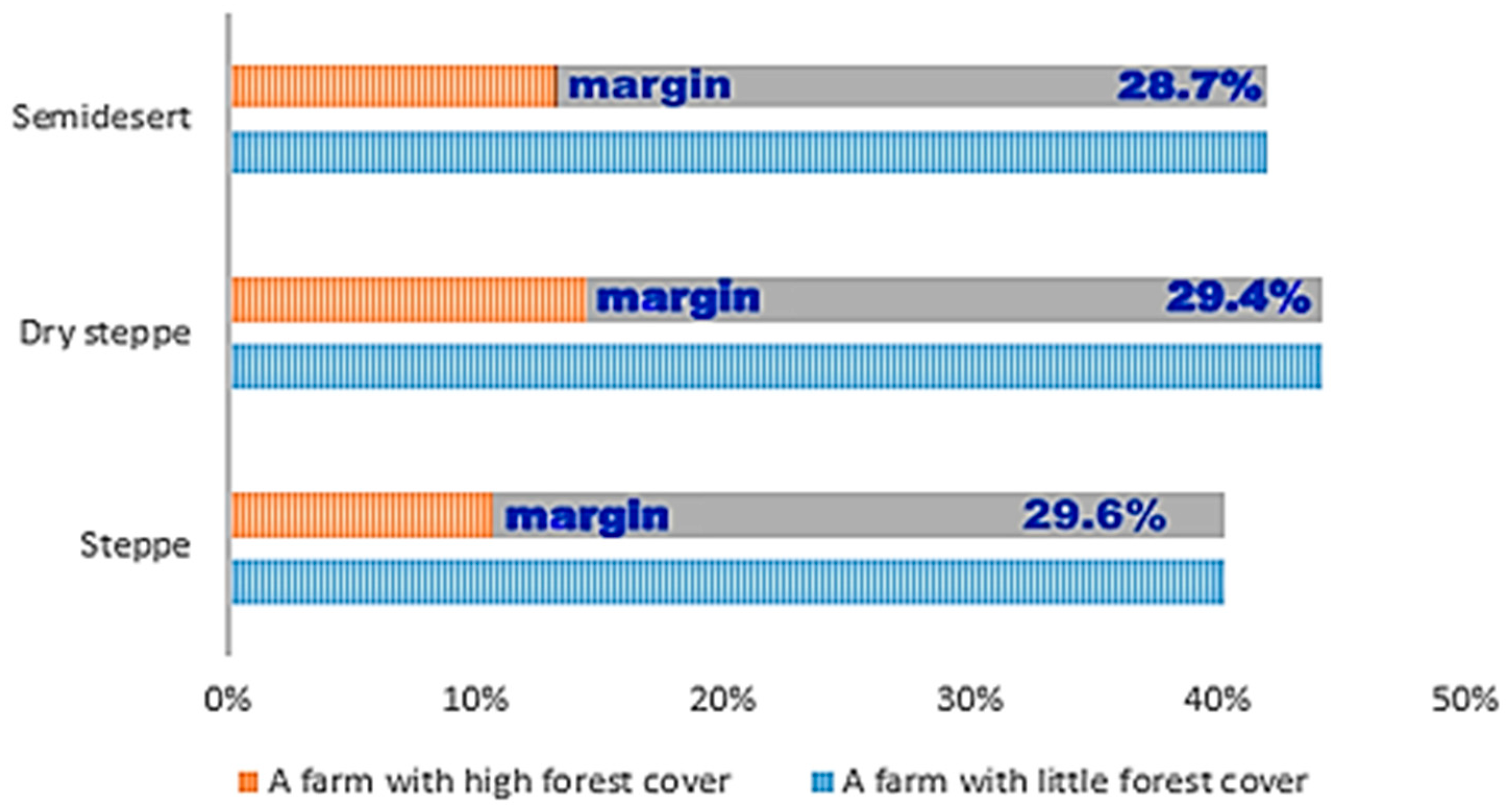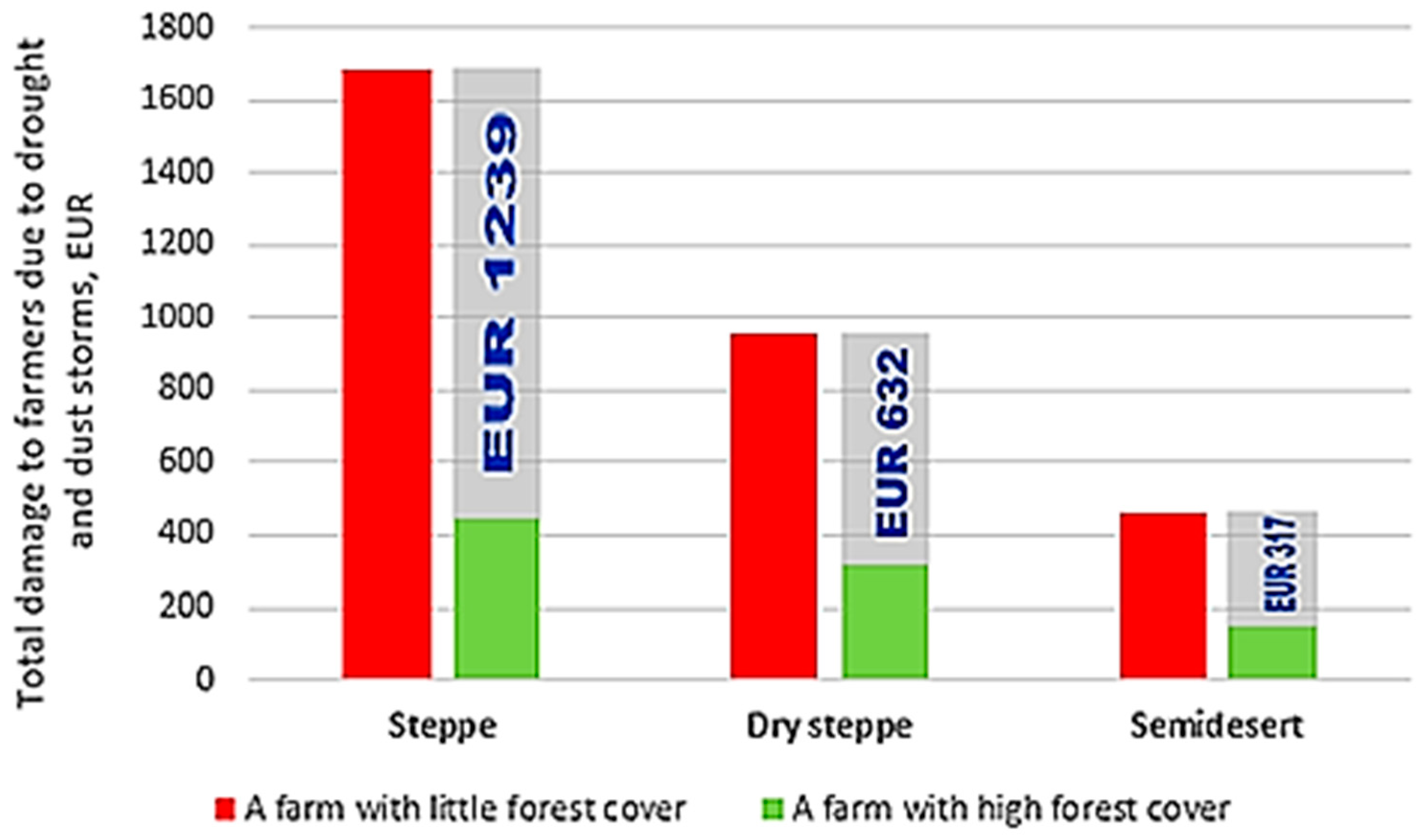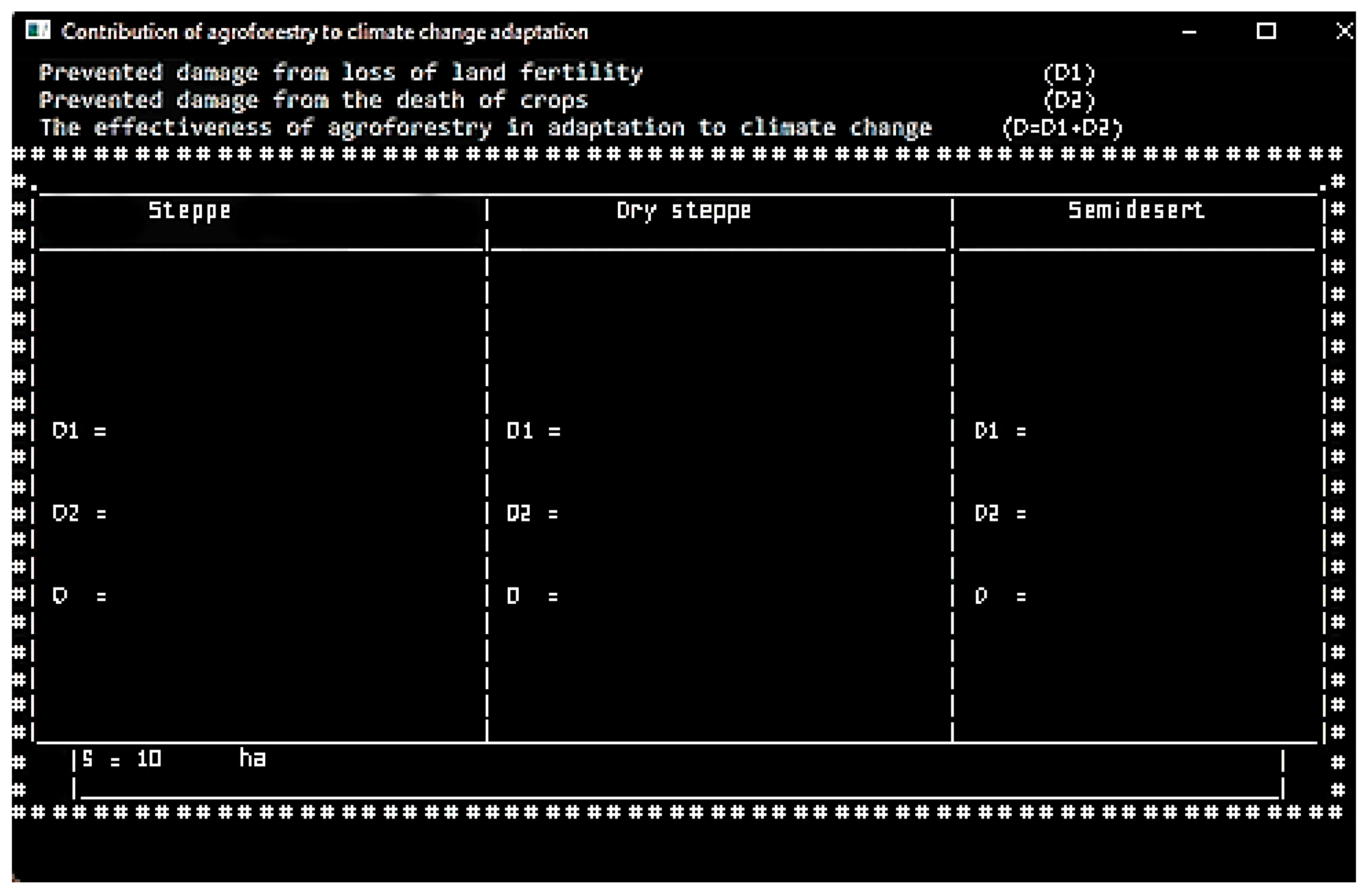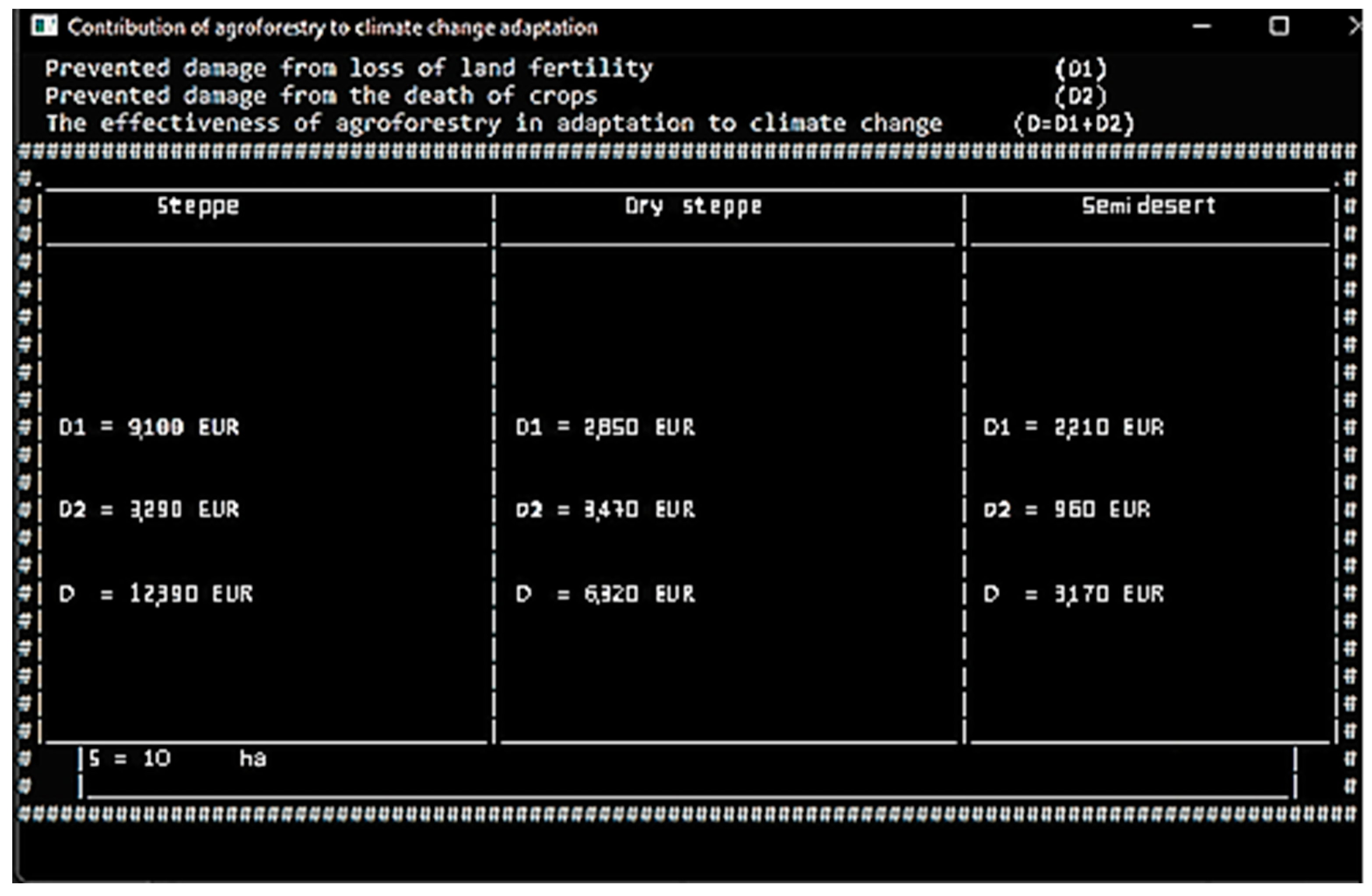Assessment of the Impact of Forest Reclamation Measures for the Adaptation of Agriculture to Climate Change in the South of the Russian Plain
Abstract
1. Introduction
2. Materials and Methods
2.1. Case Study Sites
- The first group of farms did not have forest plantations on their lands or had only scattered, single-standing trees that did not form a complete agroforestry system and did not fully perform the functions of protecting land from negative climatic phenomena. Thus, the forest cover of the territory was ≈0.0%.
- The second group of farms had a complete system of forest plantations on their lands, fully protecting the adjacent territory from natural anomalous phenomena. The protective forest cover of this territory is optimal and amounts to 3.5%–3.8%.
2.2. Data Collection
2.3. Data Analyses
2.3.1. Evaluation of the Effectiveness and Efficiency of Agroforestry Measures to Adapt Agriculture to Climate Change
2.3.2. Regional Computational Mathematical Model for Assessing the Effectiveness of Agroforestry in Adaptation to Climate Change, Implementing a Diagnostic Algorithm
3. Results
3.1. Evaluation of the Effectiveness and Efficiency of Agroforestry Measures to Adapt Agriculture to Climate Change
3.2. Regional Computational Mathematical Model for Assessing the Effectiveness of Agroforestry in Adaptation to Climate Change, Implementing a Diagnostic Algorithm
4. Discussion
5. Conclusions
Author Contributions
Funding
Data Availability Statement
Conflicts of Interest
References
- Pielke, R.A. Land Use and Climate Change. Science 2005, 310, 1625–1626. [Google Scholar] [CrossRef] [PubMed]
- Gettelman, A.; Rood, R.B. Climate change and global warming. In Demystifying Climate Models. Earth Systems Data and Models; Springer: Berlin/Heidelberg, Germany, 2016; Volume 2, Available online: https://www.researchgate.net/publication/300418364_Climate_Change_and_Global_Warming (accessed on 10 May 2023).
- Climate Change 2021: The Physical Science Basis. Sixth Assessment Report; Integovernmental Panel Clim Chang (IPCC), 2021. Available online: https://www.ipcc.ch/report/sixth-assessment-report-working-group-i/ (accessed on 10 May 2023).
- Thissen, W. Why agroforestry is a promising climate change solution. reNature 2020, March 11. Available online: https://www.renature.co/articles/why-agroforestry-is-a-promising-climate-change-solution/ (accessed on 24 May 2023).
- National Sustainable Agriculture Coalition. Agriculture and Climate Change: Policy Imperatives and Opportunities to Help Producers Meet the Challenge; U.S. Department of Agriculture: Washington, DC, USA, 2019. Available online: https://sustainableagriculture.net/wp-content/uploads/2019/11/NSAC-Climate-Change-Policy-Position_paper-112019_WEB.pdf (accessed on 24 May 2023).
- Weiland, S.; Hickmann, T.; Lederer, M.; Marquardt, J.; Schwindenhammer, S. The 2030 Agenda for Sustainable Development: Transformative Change through Sustainable Development Goals? Politics Gov. 2021, 9, 90–95. [Google Scholar] [CrossRef]
- Waldron, A.; Garrity, D.; Malhi, Y.; Girardin, C.; Miller, D.; Seddon, N. Agroforestry Can Enhance Food Security While Meeting Other Sustainable Development Goals. Trop. Conserv. Sci. 2017, 10, 194008291772. [Google Scholar] [CrossRef]
- Korneeva, E.A. Efficiency of financing of forest reclamation measures for ensuring sustainable development of agricultural regions in the South of the European territory of Russia. Econ. Reg. 2020, 16, 871–883. [Google Scholar] [CrossRef]
- Manaenkov, A.S.; Korneeva, E.A. Biogeographic aspects of assessing the effectiveness of protection of arable land by forest strips. Vestn. Mosk. Univ. Seriya 5 Geografiya 2021, 3, 48–54. [Google Scholar]
- Charles, R.L.; Munushi, P.K.T.; Nzunda, E.F. Agroforestry as adaptation strategy under climate change in Mwanga District, Kilimanjaro, Tanzania. Int. J. Environ. Prot. 2013, 3, 29–38. [Google Scholar]
- Garrett, H.E.; Buck, L. Agroforestry practice and policy in the United States of America. For. Ecol. Manag. 1997, 91, 5–15. [Google Scholar] [CrossRef]
- Jose, S. Agroforestry for ecosystem services and environmental benefits: An overview. Agrofor. Syst. 2009, 76, 1–10. [Google Scholar] [CrossRef]
- Mbow, C.; Smith, P.; Skole, D.; Duguma, L.; Bustamante, M. Achieving mitigation and adaptation to climate change through sustainable agroforestry practices in Africa. Curr. Opin. Environ. Sustain. 2014, 6, 8–14. [Google Scholar] [CrossRef]
- Chavan, S.; Newaj, R.; Keerthika, A.; Ram, A.; Jha, A.; Kumar, A. Agroforestry for Adaptation and Mitigation of Climate Change. Popular Kheti 2014, 2, 214–219. [Google Scholar]
- Sahoo, S.; Lenka, B.; Raj, D.; Jhariya, M. Climate change impacts and mitigation through sustainable agroforestry practices. In Advances in Sustainable Development and Management of Environmental and Natural Resources; Economic Outlook and Opinions; Prasad, R., Jhariya, M., Banerjee, A., Eds.; Apple Academic Press Inc.: Palm Bay, FL, USA, 2021; Volume 1, pp. 265–308. [Google Scholar]
- Lal, R. Soil erosion impact on agronomic productivity and environment quality. Crit. Rev. Plant Sci. 1998, 17, 319–464. [Google Scholar] [CrossRef]
- Dolgilevich, M.I. Dust Storms and Agroforestry Measures; Kolos: Moscow, Russia, 1978. [Google Scholar]
- Natural and Agricultural Zoning of the USSR Land Fund; Kolos: Moscow, Russia, 1985.
- Sazhin, A.N.; Kulik, K.N.; Vasiliev, Y.I. Weather and Climate of the Volgograd Region; All-Russian Research Institute of Agroforestry: Volgograd, Russia, 2010. [Google Scholar]
- Korneeva, E.A.; Belyaev, A.I. Assessment of Ecological and Economic Efficiency of Agroforestry Systems in Arid Conditions of the Lower Volga. Forests 2022, 13, 1248. [Google Scholar] [CrossRef]
- The Official Portal of the Committee of Agriculture of the Volgograd Region. Available online: https://ksh.volgograd.ru/ (accessed on 1 May 2023).
- Volgograd region in numbers. In 2020 Brief Collection. Territorial Administration of the Federal State Service Statistics for Volgograd; Volgogradstat: Volgograd, Russia, 2021; Available online: https://volgastat.gks.ru/storage/mediabank/whW83IA5/02_2020_31052021.pdf (accessed on 1 May 2023).
- Korneeva, E.A. Forest reclamation as a factor of sustainable development of agricultural production in the Volgograd region. AIC Econ. Manag. 2019, 6, 55–63. [Google Scholar] [CrossRef]
- Korneeva, E.A. Evaluation of Environmental Damage Associated with Desertification of Arid Territories on the South of European Russia. Arid. Ecosyst. 2023, 13, 59–64. [Google Scholar] [CrossRef]
- Kuhlman, T.; Reinhard, S.; Gaaf, A. Estimating the costs and benefits of soil conservation in Europe. Land Use Policy 2010, 27, 22–32. [Google Scholar] [CrossRef]
- Cai, Z.; Aguilar, F.X. Economic valuation of agroforestry ecosystem services. In Agroforestry and Ecosystem Services; Udawatta, R.P., Jose, S., Eds.; Springer: Cham, Switzerland, 2021. [Google Scholar] [CrossRef]
- Niskanen, A. Value of external environmental impacts of reforestation in Thailand. Ecol. Econ. 1998, 26, 287–297. [Google Scholar] [CrossRef]
- Kogut, B. Assessment of the humus content in arable soils of Russia. Eurasian Soil Sci. 2012, 45, 843–851. [Google Scholar] [CrossRef]
- Agrochemical Characteristics of Soils of the USSR; Volga Region; Nauka: Moscow, Russia, 1966.
- Tribunskaya, V.M. Economic Efficiency of Protective Forest Plantations in the System of Soil Protection from Erosion; Agropromizdat: Moscow, Russia, 1990. [Google Scholar]
- Agro-Industrial Portal of the South of Russia. Available online: https://www.agroyug.ru/ (accessed on 17 October 2022).
- Adaptive Landscape Farming System of the Volgograd Region for the Period up to 2015; IPK Niva: Volgograd, Russia, 2009.
- Makate, C.; Makate, M.; Mango, N.; Siziba, S. Increasing resilience of smallholder farmers to climate change through multiple adoption of proven climate-smart agriculture innovations. Lessons from Southern Africa. J. Environ. Manag. 2019, 231, 858–868. [Google Scholar] [CrossRef]
- Smith, J.; Pearce, B.D.; Wolfe, M.S. Reconciling productivity with protection of the environment: Is temperate agroforestry the answer? Renew Agric Food Syst. 2012, 28, 80–92. [Google Scholar] [CrossRef]
- Zomer, R.J.; Trabucco, A.; Coe, R.; Place, F. Trees on Farm: Analysis of Global Extent and Geographical Patterns of Agroforestry; ICRAF Working Paper No. 89; World Agroforestry Centre: Nairobi, Kenya, 2009. [Google Scholar]
- Ellison, D.; Morris, C.E.; Locatelli, B.; Sheil, D.; Cohen, J.; Murdiyarso, D.; Gutierrez, V.; van Noordwijk, M.; Creed, I.F.; Pokorny, J.; et al. Trees, forests and water: Cool insights for a hot world. Glob. Environ. Chang. 2017, 43, 51–61. [Google Scholar] [CrossRef]
- Nyong, A.P.; Ngankam, T.M.; Felicite, T.L. Enhancement of resilience to climate variability and change through agroforestry practices in smallholder farming systems in Cameroon. Agroforest Syst. 2020, 94, 687–705. [Google Scholar] [CrossRef]
- Manaenkov, A.S.; Korneeva, E.A. Ecological and economic efficiency of forest reclamation of agricultural lands of the Lower Volga region. Proc. Nizhnevolzhsky Agrouniversitetskiy Complex Sci. High. Prof. Educ. 2014, 4, 194–198. [Google Scholar]
- Young, A. Agroforestry for Soil Conservation; CTA: Wageningen, The Netherlands, 1995. [Google Scholar]
- Noordwijk, M.; Hoang, M.H.; Neufeldt, H.; Öborn, I.; Yatich, T. How Trees and People Can Co-Adapt to Climate Change: Reducing Vulnerability through Multifunctional Agroforestry Landscapes; World Agroforestry Centre (ICRAF): Nairobi, Kenya, 2011. [Google Scholar]
- Lin, B.B. Agroforestry management as an adaptive strategy against potential microclimate extremes in coffee agriculture. Agric. For. Meteorol. 2007, 144, 85–94. [Google Scholar] [CrossRef]
- Muschler, R.G. Agroforestry: Essential for sustainable and climate-smart land use? In Tropical Forestry Handbook; Pancel, L., Köhl, M., Eds.; Springer: Berlin/Heidelberg, Germany, 2016. [Google Scholar]
- Burgess, P. Agroforestry in the UK. Q. J. For. 2017, 111, 111–116. [Google Scholar]
- Wolde, Z. The Role of Agroforestry in Soil and Water Conservations; LAP LAMBERT Academy Publishing: Saarbrucken, Germany, 2015. [Google Scholar]
- Pimentel, D.; Harvey, C.; Resosudarmo, P.; Sinclair, K.; Kurz, D.; McNair, M.; Crist, S.; Shpritz, L.; Fitton, L.; Saffouri, R.; et al. Environmental and economic costs of soil erosion and conservation benefits. Science 1995, 267, 1117–1123. [Google Scholar] [CrossRef]
- Zhao, Y.; Wu, J.; He, C.; Ding, G. Linking wind erosion to ecosystem services in drylands: A landscape ecological approach. Landsc. Ecol. 2017, 32, 2399–2417. [Google Scholar] [CrossRef]
- Zipper, S.C.; Qiu, J.; Kucharik, C.J. Drought effects on US maize and soybean production: Spatiotemporal patterns and historical changes. Environ. Res. Lett. 2016, 11, 09402. [Google Scholar] [CrossRef]
- Matiu, M.; Ankerst, D.P.; Menzel, A. Interactions between temperature and drought in global and regional crop yield variability during 1961–2014. PLoS ONE 2017, 12, e0178339. [Google Scholar] [CrossRef]
- Lesk, C.; Rowhani, P.; Ramankutty, N. Influence of extreme weather disasters on global crop production. Nature 2016, 529, 84–87. [Google Scholar] [CrossRef]
- Dai, A. Increasing drought under global warming in observations and models. Nat. Clim. Chang. 2013, 3, 52–58. [Google Scholar] [CrossRef]
- Huang, S.; Leng, G.; Huang, Q.; Xie, Y.; Liu, S.; Meng, E.; Li, P. The asymmetric impact of global warming on US drought types and distributions in a large ensemble of 97 hydro-climatic simulations. Sci. Rep. 2017, 7, 5891. [Google Scholar] [CrossRef]
- Quandt, A.; Neufeldt, H.; McCabe, J.T. The role of agroforestry in building livelihood resilience to floods and drought in semiarid Kenya. Ecol. Soc. 2017, 22, 10. [Google Scholar] [CrossRef]
- Raj, A.; Jhariya, M.K.; Yadav, D.K.; Banerjee, A.; Meena, R.S. Agroforestry: A holistic approach for agricultural sustainability. In Sustainable Agriculture, Forest and Environmental Management; Jhariya, M.K., Ed.; Springer Nature: Singapore, 2019; pp. 101–131. [Google Scholar]
- Raj, A.; Jhariya, M.K.; Yadav, D.K.; Banerjee, A.; Toppo, P. Agroforestry for climate change mitigation, natural resource management, and livelihood security. In Climate Change and Agroforestry System: Adaptation and Mitigation Strategies; Raj, A., Jhariya, M.K., Yadav, D.K., Banerjee, A., Eds.; CRC Press: Boca Raton, FL, USA; Taylor & Francis Group: Abingdon, UK, 2020; pp. 27–46. [Google Scholar]
- Zhao, C.; Liu, B.; Piao, S.; Wang, X.; Lobell, D.B.; Huang, Y.; Huang, M.; Yao, Y.; Bassu, S.; Ciais, P. Temperature increase reduces global yields of major crops in four independent estimates. Proc. Natl. Acad. Sci. USA 2017, 114, 9326–9331. [Google Scholar] [CrossRef]
- Briggs, S. Agroforestry: A new approach to increasing farm production. In Nuffield Foundation Report; The NFU Mutual Charitable Trust: Stratford upon Avon, UK, 2011. [Google Scholar]
- Rulev, A.S.; Pugachova, A.M. Formation of a new agroforestry paradigm. Bull. Russ. Acad. Sci. 2019, 10, 1044–1051. [Google Scholar] [CrossRef]
- Pugacheva, A.M. The influence of homogeneous stands on the recovery of secondary virgin landsin agroforestry landscapes of dry steppes. Biol. Bull. 2021, 2, 184–192. [Google Scholar]
- Brown, S.E.; Miller, D.C.; Ordonez, P.J.; Baylis, K. Evidence for the impacts of agroforestry on agricultural productivity, ecosystem services, and human well-being in high-income countries: A systematic map protocol. Environ. Evid. 2018, 7, 24. [Google Scholar] [CrossRef]
- Jose, S.; Gold, M.A.; Garrett, H.E. The future of temperate agroforestry in the United States. In Agroforestry—The Future of Global Land Use; Nair, P.K.R., Garrity, D., Eds.; Springer: Dordrecht, The Netherlands, 2012; pp. 217–245. [Google Scholar]
- Jacobson, M.; Kar, S. Extent of Agroforestry Extension Programs in the United States. J. Ext. 2013, 51, 31. [Google Scholar] [CrossRef]
- Lassoie, J.P.; Buck, L.E.; Current, D. The development of agroforestry as an integrated land use management strategy. In North American Agroforestry: An Integrated Science and Practice, 2nd ed.; Gene Garrett, H.E., Ed.; American Society of Agronomy: Washington, DC, USA, 2009; pp. 1–24. [Google Scholar]
- Brandle, J.R.; Hodges, L.; Zhou, X.H. Windbreaks in North American agricultural systems. Agrofor. Syst. 2004, 61, 65–78. [Google Scholar] [CrossRef]
- Fagerholm, N.; Torralba, M.; Burgess, P.J.; Plieninger, T. A systematic map of ecosystem services assessments around European agroforestry. Ecol. Ind. 2016, 62, 47–65. [Google Scholar] [CrossRef]
- Torralba, M.; Fagerholm, N.; Burgess, P.J.; Moreno, G.; Plieninger, T. Do European agroforestry systems enhance biodiversity and ecosystem services? A meta-analysis. Agric. Ecosyst. Environ. 2016, 230, 150–161. [Google Scholar] [CrossRef]
- Burgess, P.J.; Rosati, A. Advances in European agroforestry: Results from the AGFORWARD project. Agrofor. Syst. 2018, 92, 801–810. [Google Scholar] [CrossRef]
- Zomer, R.J.; Trabuco, A.; Coe, R.; Place, F.; Noordwijk, M.; Xu, J. Trees on Farms: An Update and Reanalysis of Agroforestry’s Global Extent and Socio-Ecological Characteristics; Working Paper 179; World Agroforestry Centre (ICRAF) Southeast Asia Regional Program: Bogor, Indonesia, 2014. [Google Scholar]
- Kumar, B.M.; Singh, A.K.; Dhyani, S.K. South Asian agroforestry: Traditions, transformations, and prospects. In Agroforestry—The Future of Global Land Use; Springer: Dordrecht, The Netherlands, 2012; pp. 359–389. [Google Scholar]
- Basu, J.P. Agroforestry, climate change mitigation and livelihood security in India. N. Z. J. For. Sci. 2014, 44, S11. [Google Scholar] [CrossRef]
- Paudel, Y.; Shrestha, S. Agroforestry Practices Prevailing in SAARC Countries: A Review. Indones. J. Soc. Environ. Issues IJSEI 2022, 3, 10–18. [Google Scholar] [CrossRef]
- Zheng, X.; Zhu, J.; Xing, Z. Assessment of the effects of shelterbelts on crop yields at the regional scale in Northeast China. Agric. Syst. 2016, 143, 49–60. [Google Scholar] [CrossRef]
- Nichols, J.D.; Lee, S.M.; Reid, R.; Grant, J.C. Ecosystem services from agroforestry systems in Australia. In Agroforestry and Ecosystem Services; Udawatta, R.P., Jose, S., Eds.; Springer: Cham, Switzerland, 2021. [Google Scholar] [CrossRef]
- Bird, P.R.; Bicknell, D.; Bulman, P.A.; Burke, S.J.A.; Leys, J.F.; Parker, J.N.; Vandersommen, F.J.; Voller, P. The role of shelter in Australia for protecting soils, plants and livestock. Agrofor. Syst. 1992, 20, 59–86. [Google Scholar]
- Augère-Granie, M.-L. Agroforestry in the European Union; European Parliamentary Research Service; European Union: Brussels, Belgium, 2020. [Google Scholar]
- Mosquera-Losada, M.; Santiago-Freijanes, J.; Rois-Díaz, M.; Moreno, G.; Herder, M.D.; Aldrey-Vázquez, J.; Ferreiro-Domínguez, N.; Pantera, A.; Pisanelli, A.; Rigueiro-Rodríguez, A. Agroforestry in Europe: A land management policy tool to combat climate change. Land Use Policy 2018, 78, 603–613. [Google Scholar] [CrossRef]
- Tubalov, A.A. Features of the spread of gully erosion on the right bank of the Khoper river (within the Volgograd region). Geomorphology 2022, 53, 109–124. [Google Scholar] [CrossRef]
- Bayala, J.; Prieto, I. Water acquisition, sharing and redistribution by roots: Applications to agroforestry systems. Plant Soil 2020, 453, 17–28. [Google Scholar]
- Mosquera-Losada, M.R.; Santiago-Freijanes, J.; Pisanelli, A.; Rois, M.; Smith, J.; Herder, M.; Moreno, G.; Malignier, N.; Mirazo, J.R.; Lamersdorf, N.; et al. Extent and Success of Current Policy Measures to Promote Agroforestry across Europe; AGFORWARD European Project Policy Report: Bruxelles, Belgium, 2016. [Google Scholar]
- Investing.com: Official Currency Exchange Portal. 2023. Available online: https://ru.investing.com/currencies/usd-eur (accessed on 24 July 2023).
- Alam, M.; Olivier, A.; Paquette, A.; Dupras, J.; Revéret, J.P.; Messier, C. A general framework for the quantification and valuation of ecosystem services of tree-based intercropping systems. Agrofor. Syst. 2014, 88, 679–691. [Google Scholar]
- Domenicano, S. Using modeling to predict future scenarios: Will climate change drive agroforestry systems in temperate North America towards increased competition or complementarity? In Paper Presented at the 13th North American Agroforestry Conference; Prince Edward Island: Charlottetown, Canada, 2013. [Google Scholar]
- Lehmann, L.; Smith, J.; Westaway, S.; Pisanelli, A. Productivity and economic evaluation of agroforestry systems for sustainable production of food and non-food products. Sustainability 2020, 12, 5429. [Google Scholar]
- Korneeva, E.A. Resource-saving efficiency of agroforestry in areas prone to deflation and desertification. Res. Crops 2023, 24, 341–345. [Google Scholar]
- Korneeva, E.A. Role of agroforestry in increasing the economic fertility of arable lands in arid regions. Res. Crops 2023, 24, 373–377. [Google Scholar]






| Natural Areas | Heat Supply | Moisture Availability | Probability of Dry and Arid Years, % | ||
|---|---|---|---|---|---|
| Sum of Active Temperatures (>10 °C), °C | The Main Growing Season, Days | Precipitation, mm year−1 | Hydrothermal Coefficient | ||
| Steppe zone | 2719 | 160–180 | 389 | 0.75 | 0.45 |
| Dry steppe zone | 3090 | 160–190 | 350 | 0.55 | 0.53 |
| Semi-desert zone | 3200 | 150–175 | 250 | 0.37 | 0.70 |
| Natural Area/Farm Group | Protective Forest Cover of Arable Land, % | Type of Agricultural Crop | The Area of the Sown Crop, ha | Area of Dead Crops | |
|---|---|---|---|---|---|
| ha | % | ||||
| Steppe zone: | |||||
| Group 1 farm | ≈0.0 | sunflower | 1407 | 567 | 40.3 |
| Farming 2 groups | 3.8 | sunflower | 1400 | 150 | 10.7 |
| Dry steppe zone: | |||||
| Group 1 farm | ≈0.0 | spring wheat | 4091 | 1810 | 44.2 |
| Farming 2 groups | 3.5 | spring wheat | 3519 | 520 | 14.8 |
| Semi–desert zone: | |||||
| Group 1 farm | ≈0.0 | millet | 1509 | 634 | 42.0 |
| Farming 2 groups | 3.6 | millet | 543 | 72 | 13.3 |
| Soil Type/Farm Group | Protective Forest Cover of Arable Land, % | Loss of Humus, % | Loss of Humus, tons ha−1 | Fertilizer Equivalent, tons ha−1 | Damage to Farmers |
|---|---|---|---|---|---|
| Steppe zone: | |||||
| 1 ha of eroded ordinary chernozems: | - | 1.57 | 34.5 | 172.7 | EUR 3074 |
| Group 1 farm | ≈0.0 | - | 13.9 | 69.6 | EUR 1240 |
| Farming 2 groups | 3.8 | - | 3.7 | 18.5 | EUR 329 |
| Dry steppe zone: | |||||
| 1 ha of eroded chestnut soils: | - | 0.84 | 18.5 | 92.4 | EUR 970 |
| Group 1 farm | ≈0.0 | - | 8.2 | 40.8 | EUR 429 |
| Farming 2 groups | 3.5 | - | 2.7 | 13.7 | EUR 144 |
| Semi-desert zone: | |||||
| 1 ha of eroded light chestnut soils: | - | 0.67 | 14.7 | 73.5 | EUR 772 |
| Group 1 farm | ≈0.0 | - | 6.2 | 30.9 | EUR 324 |
| Farming 2 groups | 3.6 | - | 2.0 | 9.8 | EUR 103 |
| Natural Area/Farm Group | Protective Forest Cover of Arable Land, % | The Yield of the Dead Crop (On Average for 5 Years), kg | Selling Price, kg | Actual Costs of Replanting Crops | Damage to Farmers |
|---|---|---|---|---|---|
| Steppe zone: | |||||
| 1 ha of sunflower crops | - | 760 | EUR 1.2 | EUR 202 | EUR 1114 |
| Group 1 farm | ≈0.0 | - | - | - | EUR 449 |
| Farming 2 groups | 3.8 | - | - | - | EUR 120 |
| Dry steppe zone: | |||||
| 1 ha of spring wheat crops | - | 2000 | EUR 0.5 | EUR 192 | EUR 1192 |
| Group 1 farm | ≈0.0 | - | - | - | EUR 523 |
| Farming 2 groups | 3.5 | - | - | - | EUR 176 |
| Semi–desert zone: | |||||
| 1 ha of millet crops | - | 600 | EUR 0.2 | EUR 216 | EUR 336 |
| Group 1 farm | ≈0.0 | - | - | - | EUR 141 |
| Farming 2 groups | 3.6 | - | - | - | EUR 45 |
Disclaimer/Publisher’s Note: The statements, opinions and data contained in all publications are solely those of the individual author(s) and contributor(s) and not of MDPI and/or the editor(s). MDPI and/or the editor(s) disclaim responsibility for any injury to people or property resulting from any ideas, methods, instructions or products referred to in the content. |
© 2023 by the authors. Licensee MDPI, Basel, Switzerland. This article is an open access article distributed under the terms and conditions of the Creative Commons Attribution (CC BY) license (https://creativecommons.org/licenses/by/4.0/).
Share and Cite
Korneeva, E.A.; Belyaev, A.I. Assessment of the Impact of Forest Reclamation Measures for the Adaptation of Agriculture to Climate Change in the South of the Russian Plain. Forests 2023, 14, 1593. https://doi.org/10.3390/f14081593
Korneeva EA, Belyaev AI. Assessment of the Impact of Forest Reclamation Measures for the Adaptation of Agriculture to Climate Change in the South of the Russian Plain. Forests. 2023; 14(8):1593. https://doi.org/10.3390/f14081593
Chicago/Turabian StyleKorneeva, Evgenia A., and Alexander I. Belyaev. 2023. "Assessment of the Impact of Forest Reclamation Measures for the Adaptation of Agriculture to Climate Change in the South of the Russian Plain" Forests 14, no. 8: 1593. https://doi.org/10.3390/f14081593
APA StyleKorneeva, E. A., & Belyaev, A. I. (2023). Assessment of the Impact of Forest Reclamation Measures for the Adaptation of Agriculture to Climate Change in the South of the Russian Plain. Forests, 14(8), 1593. https://doi.org/10.3390/f14081593




